Another side of Thomas Moore
Published in 18th–19th - Century History, Features, Issue 3 (Autumn 2003), Volume 11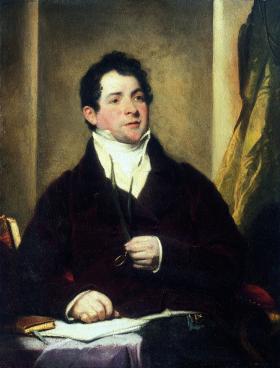
Thomas Moore by Martin Shee. (National Gallery of Ireland)
The day Robert Emmet was hanged and beheaded, 20 September 1803, Thomas Moore was in London, preparing for a long voyage. Through the offices of Lord Moira he had been appointed registrar of the Naval Prize Court in Bermuda, a sinecure that promised easy money and la dolce vita. Preoccupied with heading ‘far from the land’ himself, Emmet seems to have been far from his thoughts. Writing to his mother that day, the only sacrifice he mentioned was, as he put it, a ‘lighter’ one: his pianoforte was too heavy to travel with him. Just five years later he would immortalise Emmet in song, but since almost thirty years would pass before he made explicit reference to his friendship with the rebel, the overall effect has long suggested a certain apathy in the cause of Ireland. As all aspects of Emmet’s life are under the microscope this year, perhaps it is also time to reconsider the reputation of one of his most famous friends.
Trinity and rebellion
They first met in 1794, as Trinity undergraduates. Emmet was Moore’s senior by a year and already an established figure in the college. ‘I found him in full reputation,’ he recollected in middle age, ‘not only from his learning and eloquence, but also for the blamelessness of his life, and the grave suavity of his manners.’ While Emmet was at his ease in the university, following in the footsteps of his highly successful brothers, Moore was less assured. Only recently had the interdiction on Catholic students been revoked, and certain restrictions were still in force: ‘I was myself among the first of the young Helots of the land, who hastened to avail themselves of the new privilege of being educated in their country’s university,—though still excluded from all share in those college honours and emoluments by which the ambition of the youths of the ascendant class was stimulated and rewarded’. Moore seems to have idolised Emmet at first, but as members of the same debating society this matured into an equable friendship. Later they would attend the Historical Society together and, as the minute-book records, were occasionally fined together for ducking out early. They were both enthusiastic about Edward Bunting’s collection of ancient Irish music, and the famous scene of Moore at the piano, vamping out the chords of ‘The Red Fox’, as Emmet exclaims ‘Oh that I were at the head of twenty thousand men, marching to that air!’ is one of the iconic intersections of literature and politics in Irish history.
Despite the very public oratorical acrobatics both men performed in the various debating societies, as the United Irish conspiracy gathered momentum a culture of secrecy spread through the college. While Emmet’s centrality in the radical element is a matter of record, Moore seems to have been unwittingly confined to the fringes. As a Catholic, he claimed automatically to have been ‘born a rebel’ and his family had good rebel credentials. Grocers in Aungier Street, his parents were intimates of the revolutionary scene—young Tom was once dandled on Napper Tandy’s knee—but they did not go beyond passive support. Instead, they fostered a more gentlemanly kind of Enlightenment Patriotism, one that harked back to the days of the Volunteers, 1782, and the policies of Grattan and Flood. By 1797, however, the eighteen-year-old Moore was intoxicated by the new revolutionary spirit—‘To form any adequate idea of the feverish excitement of the public mind at this period one must not only have lived through it, as I did, but have been also mixed up, as I was, with the views, hopes, and feelings of every passing hour’—and forgot to hold his tongue, with serious consequences. On 2 December a long blustering article appeared anonymously in the United Irish paper, The Press, addressed ‘To The Students of Trinity College’, urging ‘You, my fellow-students’ to ‘shew those ministerial minions—those political calamities that insult us—that Ireland has Sons untutored in the school of corruption, who love her Liberties, and, in the crisis, will die for them’.
Stirring as it may have been, the piece had about as much authenticity as the Ossianic fragment Moore had published six weeks before. Although indicative of a general mood, it was little more than a sabre-rattling performance, full of radical chic, in love with its own language, as Moore was never privy to the inner workings of the rebel cells in college; garrulous, convivial, and prone to shows of recital, he would have made an unfortunate recruit. On one of their strolls in the countryside some days later, Moore confessed his authorship of the article to Emmet, who ‘owned to me that . . . he could not help regretting that the public attention had thus been drawn to the politics of the University, as it might have the effect of awakening the vigilance of the college authorities’. Emmet was proved right. The following spring the authorities organised an inquisition in the college, at which he was expelled in absentia. Moore, on the other hand, was interrogated, but as he knew so little was allowed to stay. In any case, that day in the fields Emmet had already taught him the virtue of silence: ‘I could not help being struck with the manliness of the view which I saw he took of what men ought to do in such times and circumstances, namely, not to talk or write about their intentions, but to act.’
When the time to act came, in 1798, Moore was at home, ill in bed. Years later he could still recall ‘the feelings of awe produced through the city, by the going out of the lamps one after another, towards midnight’. He knew many who rose up and were cut down, ‘and these I was now doomed to see,’ he wrote in his biography of Lord Edward Fitzgerald, ‘in their several ways, victims,—of that very ardour of patriotism which had been one of the sources of my affection for them, and in which, through almost every step but the last, my sympathies had gone along with them’. Though written over thirty years after the event, there is no reason to doubt Moore’s sincerity or accuracy in recollecting youthful emotions. Despite his rhetoric in the Press, he could not condone killing for the cause, and while he admired the men of ’98 he saw that their principles had led only to the gibbet and the Act of Union. His parents’ ideals, on the other hand, those of the older constitutional patriots, still rang true, but the time was not right to publicly espouse them. After the Union, and into the early years of the Napoleonic wars, when Emmet was preparing the 1803 rising, Moore abandoned his student radicalism. Prudently, even opportunistically, he heeded his friend’s injunction, and said and wrote nothing about rebellion; instead, he moved to London, began publishing verse, made a name for himself, and set sail for Bermuda.
Emmet in the Irish Melodies
Moore lasted only a few months in the tropics, and after a whistle-stop tour of the eastern United States—he met Jefferson, who wore slippers and Connemara stockings, in the half-built White House—and a trip to Niagara Falls and Canada, he returned to London’s high society. Critics often speak of Moore’s ‘later conservatism’ but it was in fact this period in America that prompted his most reactionary comments, as he assumed the persona of a John Bull-ish chauvinist. At Philadelphia, for example, he visited an old college friend, Edward Hudson, who had been imprisoned in Kilmainham in ’98, only to find that they now had little in common: ‘I feel awkward with Hudson now,’ he wrote to
his mother. ‘He has perhaps had reason to confirm him in his politics, and God knows I see every reason to change mine.’ Once back in London he mellowed, threw his lot in with the oppositional Whigs and, ten years after ’98, rediscovered his Irishness and Robert Emmet.
In the first number of his Irish Melodies Moore reiterates in song Emmet’s wish for ‘the charity of silence’:
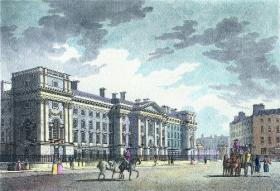
The east front of Trinity College by Robert Pool, engraved by John Lodge. Emmet and Moore first met there as undergraduates in 1794. (National Gallery of Ireland)
Oh! breathe not his name…
Unlike many of the Melodies, however, which came with footnotes detailing historical allusions, Emmet goes unidentified here, although the referent would have been easily inferred. Instead, the bare possessive pronoun cleverly conjures up a community of listeners, all in on a secret:
. . . let it sleep in the shade,
Where cold and unhonoured his relics are laid;
Sad, silent, and dark, be the tears that we shed,
As the night-dew that falls on the grass o’er his head.
Somewhat paradoxically, then, the theme of the song is silence—whatever you say, say nothing. But in this conspiratorial quiet, action is also urged. We, the interpolated audience, are asked to reflect as we grieve—the tempo given is ‘pensively’—and, more importantly, to remember. This act of memory promises to rejuvenate not only Emmet but also Ireland, and ourselves:
But the night-dew that falls, tho’ in silence it weeps,
Shall brighten with verdure the grave where he sleeps,
And the tear that we shed, though in secret it rolls,
Shall long keep his memory green in our souls.
Emmet was still in the dreamtime of Irish martyrdom three years later when Moore returned to his myth, this time focusing on Sarah Curran in the same oblique allusion:
She is far from the land where her young hero sleeps . . .
Again, remembrance and secrecy are dramatised in the conflict between inner emotion and outward dissemblance:
Ah! little they think, who delight in her strains,
How the heart of the Minstrel is breaking.
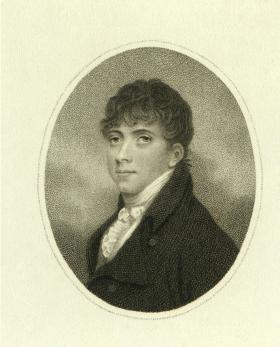
Thomas Moore as a student. (National Library of Ireland)
More veiled references —literal and figurative —are found in the long oriental poem Lalla Rookh (1817). When it appeared, Lady Holland complained, ‘Mr Moore, I have not read your “Larry O’Rourke”. I don’t like Irish stories.’ Her Bloomism was prescient, as the work gestures west, to Ireland, even as it faces east. While ‘Iran’ closely echoes ‘Erin’, Hafed and Hinda, the lovers of ‘The Fire-Worshippers’ section, are thinly disguised incarnations of Emmet and Curran:
’Tis come—his hour of martyrdom
In IRAN’s sacred cause is come;
And though his life hath pass’d away
Like lightning on a stormy day,
Yet shall his death-hour leave a track
Of glory, permanent and bright,
To which the brave of after-times,
The suffering brave, shall long look back
With proud regret . . .
These works placed Moore with Scott and Byron as the literary giants of their day, but their massive success notwithstanding, it does a disservice to Moore to dwell too long on the political implications of his poetical licence, such as, for example, the patent untruth of Curran’s burial far from the land, or the regrettable conversion for convenience of Lalla Rookh’s Hafed–Emmet character. To put these works in some context, when the Melodies began to appear, England was a state at war, and any disloyalty was severely punished. As regards Ireland, Catholic opposition was a leaderless mess after the veto controversy, and only a madman would publicly advocate rebellion (step up, P.B. Shelley). Accordingly, Moore was anxious to distance himself from the hints of rabble-rousing that some discerned in his songs:
I beg of these respected persons to believe, that there is no one who more sincerely deprecates than I do, any appeal to the passions of an ignorant and angry multitude; but that it is not through that gross and inflammable region of society, a work of this nature could ever have been intended to circulate.
Ballads, he dismissed, ‘have long lost their revolutionary powers’. This is not to exempt the poems from the rigours of analysis, but to note that limiting any discussion of Moore to his writings in verse—as has generally been the case—is to give a badly skewed impression of the span of his convictions. For more reliable expressions of his political views we must look elsewhere.
Moore’s turn to prose
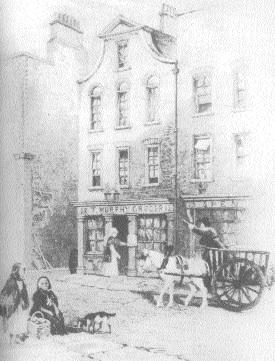
Moore’s birthplace on Aungier Street, now J.J. Smyth’s Blues Bar.
For a century and a half Moore’s reputation has rested almost entirely on the poetry of this conservative era. In his lifetime, however, he was also known for other gifts. From the ‘Appendix’ to Corruption and intolerance (1808) and his contribution to the veto controversy, A letter to the Roman Catholics of Dublin (1810), to the prefatory letters of the Melodies, Moore regularly turned to prose to express complex arguments. Indeed, from 1823, the mid-point of his writing life, he largely abandoned his career as a poet, and from this date became a prose writer of considerable repute. The turning point was a trip to the south of Ireland that summer. Moore had just spent three years dodging debtor’s prison by living on the Continent, and was now shocked by ‘the dreary shaven look of the country’: ‘Saw at Collan [Callan, Co. Kilkenny], for the first time in my life, some real specimens of Irish misery and filth; three or four cottages together exhibiting such a naked swarm of wretchedness as never met my eyes before’.
This inspired the Memoirs of Captain Rock (1824). Part satire, part history, it has been described by Joep Leerssen as ‘by far the most interesting interaction between literature and politics in Ireland in the 1820s’. In Ireland it was a sensation, prompting Sir Jonah Barrington to give thanks that the lower orders could not read. Some could, however, and Rock spawned a number of publications, often aggressively Catholic-nationalist in tenor. It created a stir in London too, being quoted twice in parliament. The time was now right, as it had not been for much of his adulthood, for Moore to address Ireland and its discontents without veils or vague allusion.
Crucially, the 1823 trip came shortly after the establishment of the new Catholic Association, and Captain Rock was at once part of, and a result of, growing Catholic self-confidence and the push for Emancipation. His next book, a biography of Richard Brinsley Sheridan, full of pro-Irish arguments, confirmed Moore as a shrewd political thinker, the Edinburgh Review judging that ‘Mr Moore has hitherto been known for the least of his valuable talents. He has passed, we suspect, with most people, for little better than a mere poet.’ He followed this with a life of his friend Byron, which Macaulay declared ‘deserves to be classed among the best specimens of English prose which our age has produced’. Curiously, ‘Oh breathe not his name’ was a particular favourite of Byron’s, leading him to ask for a similar tribute if he should fall in an Italian revolution, so that his ghost could ‘have the satisfaction of being plaintively pitied—or still more nobly commemorated’.
Rebellion defended
Emboldened by this success, and by the granting of Catholic Emancipation, Moore published in 1831 his highly controversial Life and death of Lord Edward Fitzgerald. On the eve of Reform, which many saw as a prelude to anarchy, Moore was understandably advised against pursuing this subject, but he persevered. To defend the book, he downplayed any contemporary resonances, presenting his narrative of ’98 as a pragmatic warning from history rather than a handbook of insurrection. But in order to vindicate or at least redeem Lord Edward, Moore also had to justify the bloodshed. His key tactic was to depict the rebellion as being almost solely concerned with the struggle for Catholic Emancipation: ‘Of the right of the repressed to resist,’ he reasoned, ‘few, in these days, would venture to express a doubt;—the monstrous doctrine of passive obedience having long since fallen into disrepute.’ And as Emancipation had recently become law, the insurrectionists are retrospectively vindicated: ‘. . . the concession, late, but effectual, of those measures of Emancipation and Reform which it was the first object of Lord Edward and his brave associates to obtain, has set a seal upon the general justice of their cause which no power of courts or courtiers can ever do away’. Similarly, Emmet’s rising is given this post-Emancipation spin and, after three decades of silence and insinuation, Moore could publicly hail his friend as a paragon of morality: ‘Were I to number . . . the men, among all I have ever known, who appeared to combine, in the greatest degree, pure moral worth with intellectual power, I should, among the highest of the few, place Robert Emmet.’
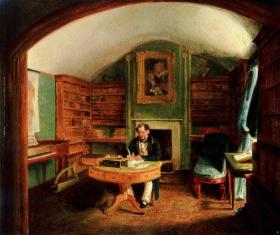
Thomas Moore in his study at Sloperton Cottage, English school. (National Gallery of Ireland)
Conclusion
After publishing a defence of Catholicism, the Travels of an Irish gentleman in search of a religion (1833), Moore embarked upon his last, longest, most ambitious work, a four-volume History of Ireland (1835–46). It was a punishing task, prompting one biographer to suggest that Moore died in the service of Ireland as truly as did Emmet or Fitzgerald, ‘except death was merciful to them and came quickly, whereas in Moore’s case it was to be protracted over interminable years’. There is a good deal of truth in this, especially in so far as it emphasises Moore’s longevity. Juxtaposing their lives at any one moment—such as late September 1803—invariably works to Moore’s disadvantage. But taking the long view, 200 years after Emmet’s rising, just over 150 since Moore’s death, their relative achievements compare more favourably. While his friend died for a cause, Moore took the different, perhaps more contemporary, path of choosing life and its inevitable compromises. As a result his legacy is complex, encompassing not just the Irish Melodies on which his reputation has misleadingly and reductively come to rest, but also his undervalued political prose of the later years. With justification, then, Moore had confidence in this legacy: ‘I have little fear that the historian (if he ever meddles with such “small deer” as myself) will say that . . . I have shown any apathy in the cause of Ireland’.
Ronan Kelly is a Government of Ireland Fellow in the School of English, Trinity College, Dublin.
Further reading:
T. Brown, ‘Thomas Moore: a reputation’, in Ireland’s literature: selected essays (Dublin, 1988).
T. de Vere White, Tom Moore: the Irish poet (Dublin, 1977).
J. Leerssen, Remembrance and imagination: patterns in the historical and literary representation of Ireland in the nineteenth century (Dublin, 1996).
















